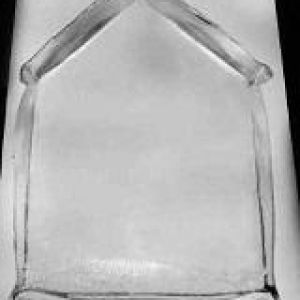–Ю–Ї—Б–Є–і –∞–ї—О–Љ–Є–љ–Є—П –°–∞–њ—Д–Є—А
–°–∞–њ—Д–Є—А —Е–Њ—А–Њ—И–Њ –Є–Ј–≤–µ—Б—В–µ–љ —Б–≤–Њ–µ–є –њ—А–Њ—З–љ–Њ—Б—В—М—О. –І—А–µ–Ј–≤—Л—З–∞–є–љ–∞—П —В–≤–µ—А–і–Њ—Б—В—М, –≤—Л—Б–Њ–Ї–∞—П –њ—А–Њ—З–љ–Њ—Б—В—М –Є —В—А–µ—Й–Є–љ–Њ—Б—В–Њ–є–Ї–Њ—Б—В—М –і–µ–ї–∞—О—В –µ–≥–Њ –Њ—В–ї–Є—З–љ—Л–Љ –≤—Л–±–Њ—А–Њ–Љ –Љ–∞—В–µ—А–Є–∞–ї–∞ –і–ї—П –≤—Л—Б–Њ–Ї–Њ–њ—А–Њ–Є–Ј–≤–Њ–і–Є—В–µ–ї—М–љ–Њ–є –Њ–њ—В–Є–Ї–Є.
–Э–∞—И–∞ –Ї–Њ–Љ–њ–∞–љ–Є—П –≤—Л—А–∞—Й–Є–≤–∞–µ—В –Ї—А–Є—Б—В–∞–ї–ї—Л –Љ–µ—В–Њ–і–Њ–Љ –≥–Њ—А–Є–Ј–Њ–љ—В–∞–ї—М–љ–Њ –љ–∞–њ—А–∞–≤–ї–µ–љ–љ–Њ–є –Ї—А–Є—Б—В–∞–ї–ї–Є–Ј–∞—Ж–Є–Є —Б–Њ —Б–ї–µ–і—Г—О—Й–Є–Љ–Є —А–∞–Ј–Љ–µ—А–∞–Љ–Є 300x220x25 –Љ–Љ.
 
|
Main properties |
  |
|
Chemical formula |
Al2O3 |
|
Crystal class |
Hexagonal system, rhomboidal class 3m |
|
Lattice constants, A |
a=4.785, c=12.991 |
|
Density, g/cm3 |
3.98 |
|
Melting point, °K |
2303 |
| Hardness |
Knoop(daN/mm2): 1800 parallel to C-axis, 2200 perpendicular to C-axis, Mohs: 9 |
|
Optical transmission range, µm |
0.17 - 5.5 |
| Refractive index at 0.532 µm |
n0=1.7717, ne=1.76355 |
|
Water absorption |
nil |
|
Young Modulus, Gpa |
345 |
|
Shear Modulus, Gpa |
145 |
|
Bulk Modulus, Gpa |
240 |
|
Bending Modulus (Modulus of Rupture), Mpa |
420 at 20°C, 280 at 500°C |
|
Elastic Coefficient |
C11=496, C12=164, C13=115, C33=498, C44=148 |
|
Poisson ratio |
0.25-0.30 |
|
Friction Coefficient |
0.15 on steel, 0.10 on sapphire |
|
Tensile strength, MPa |
400 at 25°, 275 at 500°, 345 at 1000° |
|
Flexural strength, daN/mm2 |
35 to 39 |
|
Compressive strength, GPa |
2.0 |
|
YoungвАЩs modulus E, daN/mm2 |
3.6 x 104 do 4.4 x 104 |
|
Specific heat, J/(kg x K) |
105 at 91°K, 761 at 291°K |
|
Thermal coefficient of linear expansion, K-1,at 323K |
6.66 x 10-6 parallel to optical axis, 5 x 10-6 perpendicular to optical axis |
|
Thermal conductivity, W/(m x K) at 300K |
23.1 parallel to optical axis, 25.2 perpendicular to optical axis |
|
Resistivity, Ohm x cm |
1016 (25°), 1011 (500°), 106 (1000°) |
|
Dielectric constant |
1.5 (103 - 109 Hz, 25°) parallel to C-axis, 9.3 (103 - 109 Hz, 25°) perpendicular to C-axis |
|
Dielectric strength, V/cm |
4 x 105 |
|
Loss tangent |
1 x 10-4 |
|
Solubility |
  |
|
- in water |
insoluble |
|
- in HNO3,H2SO4, HCl, HF |
insoluble to 300 °C |
|
- in alcalis |
insoluble to 800 °C |
|
- in melts of metals  Mg, Al, Cr, Co, Ni, Na, K, Bi, Zn, Cs |
insoluble to 800-1000 ° C |
|
g -radiation stability |
No change in transmission above 2.5 mm after exposure to 107 Rads. No visible coloration after exposure to 108 Rads/hr for 60 minutes at - 195°C |
|
Proton radiation stability  |
No change in transmission below 0.3 µm after exposure to 1012 proton/cm2 total dose |
|
Chemical resistance |
Sapphire is highly inert and resistant to attack in most process environments including hydrofluoric acid and the fluorine plasma applications commonly found in semiconductor wafer processing (NF3, CF4) |
